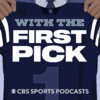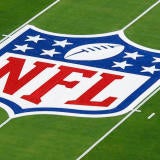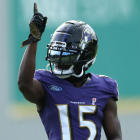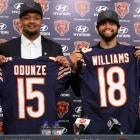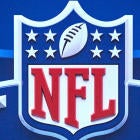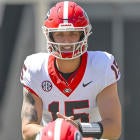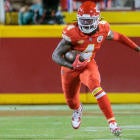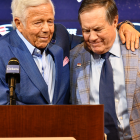
The NFL is a passing league. You know this. I know this. Everyone in and around the league knows this. And because it's a passing league, the wide receiver position has never been more important than it is right now. Perhaps it's no coincidence, then, that there are seemingly more young, good wide receivers populating the league than at any time in recent memory.
With that in mind, we're going to use this space over the next few weeks to highlight of the league's up-and-coming wideouts. Because I'm a little obsessive about this kind of stuff, we're going to break the players down into distinct categories that capture their on-field roles: Speed Demons and Deep Threats (below), Slot Mavens and Offensive Weapons (next Friday), Possession Receivers (Dec. 18), Technicians (Dec. 25), and All-Around Monsters (Jan. 1).
A couple of quick notes before we dive into the first category of players:
- The only receivers we're looking at here at players who are still on their rookie contract. That means no Davante Adams, no Julio Jones, no DeAndre Hopkins, no Keenan Allen, no Tyreek Hill, etc. We already did our in-depth look at those guys before the start of the season. While there is one player who made our top-10 list (and two who were honorable mentions) that will be featured during this series, for the most part, we are just looking at the youngsters, which means focusing on players whose future is likely brighter than their present.
- We're not exclusively looking at the best receivers, but instead all of the receivers still on their rookie deals who fit a certain mold, and have already proven to be at least nominal contributors to their offenses. Basically, anyone who has at least 15 targets this season qualifies.
Without further ado, the speed demons and deep threats (with 2020 statistics, via Pro Football Focus and Tru Media)...
| Player | Age | Yrs | Team | Rte | Rec | Tgt | Yds | TD | Yds/Rte | Tgt % |
|---|---|---|---|---|---|---|---|---|---|---|
| Marquise Brown | 23 | 2 | Ravens | 321 | 36 | 63 | 513 | 3 | 1.61 | 19.6% |
| Mecole Hardman | 22 | 2 | Chiefs | 256 | 29 | 43 | 434 | 3 | 1.70 | 16.8% |
| K.J. Hamler | 21 | 2 | Broncos | 273 | 25 | 47 | 275 | 1 | 1.01 | 17.2% |
| James Washington | 24 | 3 | Steelers | 198 | 23 | 36 | 263 | 3 | 1.33 | 18.2% |
| Jalen Reagor | 21 | 1 | Eagles | 209 | 19 | 35 | 222 | 1 | 1.06 | 16.7% |
| Andy Isabella | 24 | 2 | Cardinals | 183 | 19 | 29 | 217 | 2 | 1.19 | 15.8% |
| Henry Ruggs III | 21 | 1 | Raiders | 239 | 17 | 34 | 312 | 1 | 1.31 | 14.2% |
| Van Jefferson | 24 | 1 | Rams | 75 | 11 | 15 | 143 | 1 | 1.91 | 20.0% |
| D.J. Chark | 24 | 3 | Jaguars | 341 | 41 | 67 | 534 | 4 | 1.57 | 19.6% |
| Darius Slayton | 23 | 2 | Giants | 416 | 38 | 67 | 584 | 3 | 1.40 | 16.1% |
| Josh Reynolds | 25 | 4 | Rams | 364 | 38 | 59 | 488 | 2 | 1.34 | 16.2% |
| Michael Gallup | 24 | 3 | Cowboys | 462 | 37 | 68 | 538 | 1 | 1.16 | 14.7% |
| Darnell Mooney | 23 | 1 | Bears | 386 | 36 | 64 | 385 | 2 | 1.00 | 16.6% |
| Christian Kirk | 24 | 3 | Cardinals | 365 | 34 | 57 | 496 | 6 | 1.36 | 15.6% |
| Mike Williams | 26 | 4 | Chargers | 384 | 32 | 62 | 529 | 4 | 1.38 | 16.1% |
| Tre'Quan Smith | 24 | 3 | Saints | 325 | 27 | 35 | 321 | 3 | 0.99 | 10.8% |
| David Moore | 25 | 4 | Seahawks | 214 | 27 | 35 | 331 | 5 | 1.55 | 16.4% |
| Marquez Valdes-Scantling | 26 | 3 | Packers | 379 | 25 | 55 | 518 | 4 | 1.37 | 14.5% |
| Gabriel Davis | 21 | 1 | Bills | 301 | 22 | 39 | 354 | 4 | 1.18 | 13.0% |
| Kenny Golladay | 27 | 4 | Lions | 150 | 20 | 36 | 338 | 2 | 2.25 | 24.0% |
| Denzel Mims | 23 | 1 | Jets | 155 | 17 | 35 | 284 | 0 | 1.83 | 22.6% |
| Collin Johnson | 23 | 1 | Jaguars | 133 | 11 | 22 | 165 | 2 | 1.24 | 16.5% |
| John Hightower | 24 | 1 | Eagles | 224 | 10 | 30 | 167 | 0 | 0.75 | 13.4% |
| Tyler Johnson | 22 | 1 | Buccaneers | 135 | 10 | 15 | 118 | 2 | 0.87 | 11.1% |
The most notable thing about this group of players is that their role tends to be just as much about providing space for everyone else on the team to excel as it is about succeeding on their own. This is most apparent when looking at the target rate column, which shows how often those players have been targeted when running a pass route. (So, Marquise Brown, who has been targeted 63 times on 321 routes, has a 19.6 percent target rate.)
The collective target rate for this group of players is just 16.0 percent -- easily the lowest of the five categories of players we're tracking here. Additionally, just three of the 24 players on the list have been targeted on at least 20 percent of their routes. That, too, is the lowest rate among the five different categories of players. Granted, that makes a good deal of sense. League-wide, only 11.2 percent of passes are thrown 20 or more yards downfield.
The speed demons and deep threats on the list above also have an average route-break depth of 9.11 yards beyond the line of scrimmage, per PFF and Tru Media. Contrast that figure with, say, that of the slot mavens offensive weapons, whose average route has broken just 4.58 yards beyond the line of scrimmage, and it's easy to see why one type of player is targeted significantly less often (our slot mavens and offensive weapons have been targeted on 20.9 percent of their routes so far this season). When your primary role is to run those deeper routes, you are naturally going to be targeted less often than players who run routes that break closer to the line of scrimmage.
It's worth noting, though, that there have been extenuating circumstances surrounding the performances of some of these players. Marquise Brown, like much of the Ravens offense, has taken a step backward this year. K.J. Hamler and Jalen Reagor have dealt with injuries. Michael Gallup has seen his role neutered due to injuries to Dak Prescott and essentially the entire Dallas offensive line. Other players, like Mecole Hardman, Andy Isabella, and Marquez Valdes-Scantling, have not taken on the expanded roles that may have been expected of them coming into this season.
But because of the nature of this role, other members of this group have had a greater impact than may have been expected so early in their careers. This group of players has turned 18.8 percent of its targets into explosive plays, per PFF and Tru Media, a rate right in line with that of the All-Around Monsters group of players (19 percent). Gabriel Davis, for example, has emerged as a quality contributor to the Bills offense despite working inside of a crowded receiver unit. Darnell Mooney is looking like a solid complement to Allen Robinson in Chicago. Josh Reynolds has carved out a significant role in the Rams offense after the departure of Brandin Cooks. Denzel Mims, since returning from an injury of his own, has been a strong option for the Jets despite having to deal with near-universally horrendous quarterback play.
As mentioned, though, other players are more notable for the way they open up space within their offenses. Henry Ruggs III may not be a major contributor in terms of drawing targets, but his presence on the field has aided the Raiders in finding more targets for the likes of Darren Waller and Nelson Agholor. The same is true of Mike Williams, who has helped Justin Herbert and Keenan Allen operate in the short and intermediate areas of the field. It's true of Christian Kirk, whose ability to stretch the field vertically has benefited Kyler Murray, DeAndre Hopkins, and Chase Edmonds. And it remains true of Darius Slayton, who seemingly fulfills both roles for the Giants by being a large part of the offense and creating space for Sterling Shepard, Golden Tate, and Evan Engram.
By necessity, this type of player is not utilized as often as some others. But there's a reason coaches and general managers always talk about the need to have someone who can "take the top off the defense." It's because that type of player actually is necessary, and actually does help. If the way their careers have started is any indication, this group of guys should be helping their offenses for years to come.




